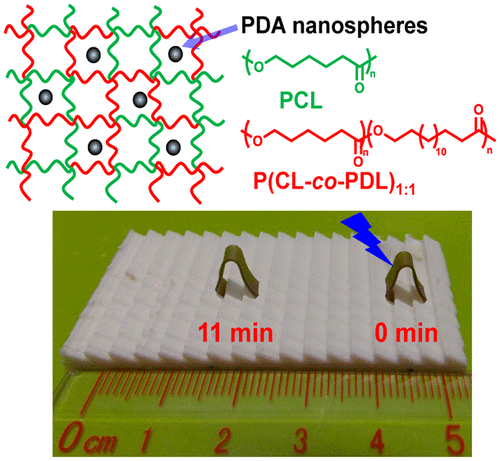当前位置:
X-MOL 学术
›
ACS Biomater. Sci. Eng.
›
论文详情
Our official English website, www.x-mol.net, welcomes your
feedback! (Note: you will need to create a separate account there.)
Two-Way Reversible Shape Memory Polymers Containing Polydopamine Nanospheres: Light Actuation, Robotic Locomotion, and Artificial Muscles
ACS Biomaterials Science & Engineering ( IF 5.4 ) Pub Date : 2018-06-20 00:00:00 , DOI: 10.1021/acsbiomaterials.8b00671 Kaojin Wang 1 , X. X. Zhu 1
ACS Biomaterials Science & Engineering ( IF 5.4 ) Pub Date : 2018-06-20 00:00:00 , DOI: 10.1021/acsbiomaterials.8b00671 Kaojin Wang 1 , X. X. Zhu 1
Affiliation

|
Two-way reversible shape memory polymers (2W-SMPs), especially those that are light-responsive, are highly desirable for many applications, especially in the biomedical field, because of the convenience of indirect heating. We have designed and prepared a series of light-actuated 2W-SMP composites by incorporating very small amounts of polydopamine (PDA) nanospheres into semicrystalline polymer networks based on biodegradable poly(ε-caprolactone) copolymers. PDA nanospheres can be well dispersed in chloroform and well mixed with the polymer network. PDA nanospheres manifest good photothermal effect because of their strong absorption of light. The variation in temperature of the polymer composites can be correlated with irradiation time, light intensity, and the content of PDA nanospheres. Equations are developed to fit the temperature changes of the materials as a function of irradiation power and of the PDA particles content for a better understanding of the kinetics of the light-to-heat conversion. These polymer composites show excellent two-way reversible shape memory effects (2W-SMEs) under stress-free condition when the light is switched on and off showing a reversible angle change of 45°. The speed of angle change is larger for polymer composites irradiated with a stronger light or with a higher content of PDA nanospheres. This is the first report on 2W-SMPs using incorporated PDA nanospheres as photothermal fillers. A moving robot is designed based on photoresponsive 2W-SMP composites, which can walk on a track with triangular saw-teeth. This composite is capable of lifting and lowering a weight, acting as artificial muscles, and its actuated stress is much higher than the maximum stress yielded by most mammalian skeletal muscles. The use of biodegradable polyesters and thermal fillers made of a natural compound dopamine makes such composites potentially useful as biomaterials.
中文翻译:

包含聚多巴胺纳米球的双向可逆形状记忆聚合物:光致动,机器人运动和人造肌肉
由于间接加热的便利性,双向可逆形状记忆聚合物(2W-SMP),尤其是那些具有光响应性的形状记忆聚合物(2W-SMP),对于许多应用,尤其是在生物医学领域中,是非常需要的。我们通过将非常少量的聚多巴胺(PDA)纳米球掺入基于可生物降解的聚(ε-己内酯)共聚物的半结晶聚合物网络中,设计并制备了一系列光致2W-SMP复合材料。PDA纳米球可以很好地分散在氯仿中,并且可以与聚合物网络充分混合。PDA纳米球由于对光的强吸收而表现出良好的光热效应。聚合物复合材料的温度变化可以与照射时间,光强度和PDA纳米球的含量相关。开发方程式以适合材料随辐照功率和PDA颗粒含量变化的温度变化,以便更好地理解光热转换的动力学。当打开和关闭灯时,这些聚合物复合材料在无应力条件下显示出出色的双向可逆形状记忆效应(2W-SMEs),可逆角度变化为45°。对于用更强的光或更高含量的PDA纳米球辐照的聚合物复合材料,角度变化的速度更大。这是有关使用掺入的PDA纳米球作为光热填料的2W-SMP的第一份报告。基于光敏2W-SMP复合材料设计的移动机器人可以在带有三角锯齿的轨道上行走。这种复合材料能够举起和减轻重量,它起着人造肌肉的作用,其驱动应力远高于大多数哺乳动物骨骼肌产生的最大应力。由天然化合物多巴胺制成的可生物降解的聚酯和热填料的使用使得这种复合材料潜在地可用作生物材料。
更新日期:2018-06-20
中文翻译:

包含聚多巴胺纳米球的双向可逆形状记忆聚合物:光致动,机器人运动和人造肌肉
由于间接加热的便利性,双向可逆形状记忆聚合物(2W-SMP),尤其是那些具有光响应性的形状记忆聚合物(2W-SMP),对于许多应用,尤其是在生物医学领域中,是非常需要的。我们通过将非常少量的聚多巴胺(PDA)纳米球掺入基于可生物降解的聚(ε-己内酯)共聚物的半结晶聚合物网络中,设计并制备了一系列光致2W-SMP复合材料。PDA纳米球可以很好地分散在氯仿中,并且可以与聚合物网络充分混合。PDA纳米球由于对光的强吸收而表现出良好的光热效应。聚合物复合材料的温度变化可以与照射时间,光强度和PDA纳米球的含量相关。开发方程式以适合材料随辐照功率和PDA颗粒含量变化的温度变化,以便更好地理解光热转换的动力学。当打开和关闭灯时,这些聚合物复合材料在无应力条件下显示出出色的双向可逆形状记忆效应(2W-SMEs),可逆角度变化为45°。对于用更强的光或更高含量的PDA纳米球辐照的聚合物复合材料,角度变化的速度更大。这是有关使用掺入的PDA纳米球作为光热填料的2W-SMP的第一份报告。基于光敏2W-SMP复合材料设计的移动机器人可以在带有三角锯齿的轨道上行走。这种复合材料能够举起和减轻重量,它起着人造肌肉的作用,其驱动应力远高于大多数哺乳动物骨骼肌产生的最大应力。由天然化合物多巴胺制成的可生物降解的聚酯和热填料的使用使得这种复合材料潜在地可用作生物材料。











































 京公网安备 11010802027423号
京公网安备 11010802027423号